Abstract
Platelet-activating factor (PAF) has been implicated as a mediator of inflammation and atherosclerosis. A specific degradative enzyme found in plasma, PAF acetylhydrolase, plays important roles in various pathophysiological events induced by PAF. Human macrophages and Hep G2 cells secrete PAF acetylhydrolase with characteristics identical to the plasma activity. Other investigators reported that apolipoprotein B may possess phospholipase A2 activity, which suggested that apolipoprotein B might be a zymogen for PAF acetylhydrolase. However, while macrophages express PAF acetylhydrolase activity, we did not detect cDNAs for apolipoprotein B in a cDNA library from these cells, indicating that macrophages do not express this protein. In contrast, Hep G2 cells had high levels of cDNA for apolipoprotein B, as expected. We next injected Xenopus laevis oocytes with poly(A)+ RNA extracted from cultured human macrophages and Hep G2 cells. Twenty-five to 50% of Xenopus oocytes injected with poly(A)+ RNA from macrophages or Hep G2 cells secreted a PAF acetylhydrolase activity (1.0-7.8 nmol/ml per h) that also utilized a synthetic oxidized phospholipid as substrate. The activity secreted by poly(A)+ RNA-injected oocytes associated with lipoproteins and transferred between the particles in a pH-dependent manner, much like the plasma activity. These experiments establish that the properties of the enzyme released from poly(A)+ RNA-injected oocytes are identical to those of the plasma form of PAF acetylhydrolase and that the activity detected is not the expression of a domain in apolipoprotein B.
Full text
PDF




Images in this article
Selected References
These references are in PubMed. This may not be the complete list of references from this article.
- Chen S. H., Yang C. Y., Chen P. F., Setzer D., Tanimura M., Li W. H., Gotto A. M., Jr, Chan L. The complete cDNA and amino acid sequence of human apolipoprotein B-100. J Biol Chem. 1986 Oct 5;261(28):12918–12921. [PubMed] [Google Scholar]
- Cladaras C., Hadzopoulou-Cladaras M., Nolte R. T., Atkinson D., Zannis V. I. The complete sequence and structural analysis of human apolipoprotein B-100: relationship between apoB-100 and apoB-48 forms. EMBO J. 1986 Dec 20;5(13):3495–3507. doi: 10.1002/j.1460-2075.1986.tb04675.x. [DOI] [PMC free article] [PubMed] [Google Scholar]
- Dumont J. N. Oogenesis in Xenopus laevis (Daudin). I. Stages of oocyte development in laboratory maintained animals. J Morphol. 1972 Feb;136(2):153–179. doi: 10.1002/jmor.1051360203. [DOI] [PubMed] [Google Scholar]
- Elstad M. R., Prescott S. M., McIntyre T. M., Zimmerman G. A. Synthesis and release of platelet-activating factor by stimulated human mononuclear phagocytes. J Immunol. 1988 Mar 1;140(5):1618–1624. [PubMed] [Google Scholar]
- Elstad M. R., Stafforini D. M., McIntyre T. M., Prescott S. M., Zimmerman G. A. Platelet-activating factor acetylhydrolase increases during macrophage differentiation. A novel mechanism that regulates accumulation of platelet-activating factor. J Biol Chem. 1989 May 25;264(15):8467–8470. [PubMed] [Google Scholar]
- Grunfeld C., Shigenaga J. K., Huang B. J., Fujita-Yamaguchi Y., McFarland K. C., Burnier J., Ramachandran J. Identification of the intact insulin receptor using a sequence-specific antibody directed against the C-terminus of the beta-subunit. Endocrinology. 1987 Sep;121(3):948–957. doi: 10.1210/endo-121-3-948. [DOI] [PubMed] [Google Scholar]
- Hanahan D. J. Platelet activating factor: a biologically active phosphoglyceride. Annu Rev Biochem. 1986;55:483–509. doi: 10.1146/annurev.bi.55.070186.002411. [DOI] [PubMed] [Google Scholar]
- Hirata M., Hayashi Y., Ushikubi F., Yokota Y., Kageyama R., Nakanishi S., Narumiya S. Cloning and expression of cDNA for a human thromboxane A2 receptor. Nature. 1991 Feb 14;349(6310):617–620. doi: 10.1038/349617a0. [DOI] [PubMed] [Google Scholar]
- Honda Z., Nakamura M., Miki I., Minami M., Watanabe T., Seyama Y., Okado H., Toh H., Ito K., Miyamoto T. Cloning by functional expression of platelet-activating factor receptor from guinea-pig lung. Nature. 1991 Jan 24;349(6307):342–346. doi: 10.1038/349342a0. [DOI] [PubMed] [Google Scholar]
- Houamed K. M., Kuijper J. L., Gilbert T. L., Haldeman B. A., O'Hara P. J., Mulvihill E. R., Almers W., Hagen F. S. Cloning, expression, and gene structure of a G protein-coupled glutamate receptor from rat brain. Science. 1991 May 31;252(5010):1318–1321. doi: 10.1126/science.1656524. [DOI] [PubMed] [Google Scholar]
- Julius D., MacDermott A. B., Axel R., Jessell T. M. Molecular characterization of a functional cDNA encoding the serotonin 1c receptor. Science. 1988 Jul 29;241(4865):558–564. doi: 10.1126/science.3399891. [DOI] [PubMed] [Google Scholar]
- Lester H. A. Heterologous expression of excitability proteins: route to more specific drugs? Science. 1988 Aug 26;241(4869):1057–1063. doi: 10.1126/science.2457947. [DOI] [PubMed] [Google Scholar]
- Liu F. T., Zinnecker M., Hamaoka T., Katz D. H. New procedures for preparation and isolation of conjugates of proteins and a synthetic copolymer of D-amino acids and immunochemical characterization of such conjugates. Biochemistry. 1979 Feb 20;18(4):690–693. doi: 10.1021/bi00571a022. [DOI] [PubMed] [Google Scholar]
- Masu Y., Nakayama K., Tamaki H., Harada Y., Kuno M., Nakanishi S. cDNA cloning of bovine substance-K receptor through oocyte expression system. 1987 Oct 29-Nov 4Nature. 329(6142):836–838. doi: 10.1038/329836a0. [DOI] [PubMed] [Google Scholar]
- Narahara H., Johnston J. M. Effects of endotoxins and cytokines on the secretion of platelet-activating factor-acetylhydrolase by human decidual macrophages. Am J Obstet Gynecol. 1993 Sep;169(3):531–537. doi: 10.1016/0002-9378(93)90614-o. [DOI] [PubMed] [Google Scholar]
- Parthasarathy S., Barnett J. Phospholipase A2 activity of low density lipoprotein: evidence for an intrinsic phospholipase A2 activity of apoprotein B-100. Proc Natl Acad Sci U S A. 1990 Dec;87(24):9741–9745. doi: 10.1073/pnas.87.24.9741. [DOI] [PMC free article] [PubMed] [Google Scholar]
- Parthasarathy S., Steinbrecher U. P., Barnett J., Witztum J. L., Steinberg D. Essential role of phospholipase A2 activity in endothelial cell-induced modification of low density lipoprotein. Proc Natl Acad Sci U S A. 1985 May;82(9):3000–3004. doi: 10.1073/pnas.82.9.3000. [DOI] [PMC free article] [PubMed] [Google Scholar]
- Patel K. D., Zimmerman G. A., Prescott S. M., McIntyre T. M. Novel leukocyte agonists are released by endothelial cells exposed to peroxide. J Biol Chem. 1992 Jul 25;267(21):15168–15175. [PubMed] [Google Scholar]
- Prescott S. M., Zimmerman G. A., McIntyre T. M. Platelet-activating factor. J Biol Chem. 1990 Oct 15;265(29):17381–17384. [PubMed] [Google Scholar]
- Satoh K., Imaizumi T., Kawamura Y., Yoshida H., Hiramoto M., Takamatsu S., Takamatsu M. Platelet-activating factor (PAF) stimulates the production of PAF acetylhydrolase by the human hepatoma cell line, HepG2. J Clin Invest. 1991 Feb;87(2):476–481. doi: 10.1172/JCI115020. [DOI] [PMC free article] [PubMed] [Google Scholar]
- Smiley P. L., Stremler K. E., Prescott S. M., Zimmerman G. A., McIntyre T. M. Oxidatively fragmented phosphatidylcholines activate human neutrophils through the receptor for platelet-activating factor. J Biol Chem. 1991 Jun 15;266(17):11104–11110. [PubMed] [Google Scholar]
- Stafforini D. M., Carter M. E., Zimmerman G. A., McIntyre T. M., Prescott S. M. Lipoproteins alter the catalytic behavior of the platelet-activating factor acetylhydrolase in human plasma. Proc Natl Acad Sci U S A. 1989 Apr;86(7):2393–2397. doi: 10.1073/pnas.86.7.2393. [DOI] [PMC free article] [PubMed] [Google Scholar]
- Stafforini D. M., Elstad M. R., McIntyre T. M., Zimmerman G. A., Prescott S. M. Human macrophages secret platelet-activating factor acetylhydrolase. J Biol Chem. 1990 Jun 15;265(17):9682–9687. [PubMed] [Google Scholar]
- Stafforini D. M., McIntyre T. M., Carter M. E., Prescott S. M. Human plasma platelet-activating factor acetylhydrolase. Association with lipoprotein particles and role in the degradation of platelet-activating factor. J Biol Chem. 1987 Mar 25;262(9):4215–4222. [PubMed] [Google Scholar]
- Stafforini D. M., McIntyre T. M., Prescott S. M. Platelet-activating factor acetylhydrolase from human plasma. Methods Enzymol. 1990;187:344–357. doi: 10.1016/0076-6879(90)87041-z. [DOI] [PubMed] [Google Scholar]
- Stafforini D. M., Prescott S. M., McIntyre T. M. Human plasma platelet-activating factor acetylhydrolase. Purification and properties. J Biol Chem. 1987 Mar 25;262(9):4223–4230. [PubMed] [Google Scholar]
- Stafforini D. M., Prescott S. M., McIntyre T. M. Platelet-activating factor acetylhydrolase in human erythrocytes. Methods Enzymol. 1991;197:411–425. doi: 10.1016/0076-6879(91)97167-w. [DOI] [PubMed] [Google Scholar]
- Stafforini D. M., Zimmerman G. A., McIntyre T. M., Prescott S. M. The platelet-activating factor acetylhydrolase from human plasma prevents oxidative modification of low-density lipoprotein. Trans Assoc Am Physicians. 1992;105:44–63. [PubMed] [Google Scholar]
- Steinberg D., Parthasarathy S., Carew T. E., Khoo J. C., Witztum J. L. Beyond cholesterol. Modifications of low-density lipoprotein that increase its atherogenicity. N Engl J Med. 1989 Apr 6;320(14):915–924. doi: 10.1056/NEJM198904063201407. [DOI] [PubMed] [Google Scholar]
- Stremler K. E., Stafforini D. M., Prescott S. M., McIntyre T. M. Human plasma platelet-activating factor acetylhydrolase. Oxidatively fragmented phospholipids as substrates. J Biol Chem. 1991 Jun 15;266(17):11095–11103. [PubMed] [Google Scholar]
- Stremler K. E., Stafforini D. M., Prescott S. M., Zimmerman G. A., McIntyre T. M. An oxidized derivative of phosphatidylcholine is a substrate for the platelet-activating factor acetylhydrolase from human plasma. J Biol Chem. 1989 Apr 5;264(10):5331–5334. [PubMed] [Google Scholar]
- Tarbet E. B., Stafforini D. M., Elstad M. R., Zimmerman G. A., McIntyre T. M., Prescott S. M. Liver cells secrete the plasma form of platelet-activating factor acetylhydrolase. J Biol Chem. 1991 Sep 5;266(25):16667–16673. [PubMed] [Google Scholar]
- Vaitukaitis J. L. Production of antisera with small doses of immunogen: multiple intradermal injections. Methods Enzymol. 1981;73(Pt B):46–52. doi: 10.1016/0076-6879(81)73055-6. [DOI] [PubMed] [Google Scholar]
- Vu T. K., Hung D. T., Wheaton V. I., Coughlin S. R. Molecular cloning of a functional thrombin receptor reveals a novel proteolytic mechanism of receptor activation. Cell. 1991 Mar 22;64(6):1057–1068. doi: 10.1016/0092-8674(91)90261-v. [DOI] [PubMed] [Google Scholar]
- Wallace R. A., Jared D. W., Dumont J. N., Sega M. W. Protein incorporation by isolated amphibian oocytes. 3. Optimum incubation conditions. J Exp Zool. 1973 Jun;184(3):321–333. doi: 10.1002/jez.1401840305. [DOI] [PubMed] [Google Scholar]



